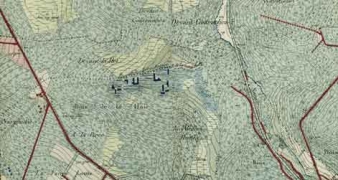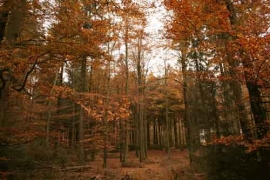|  |
Natural habitats to be Restored
The LIFE-Lomme Project seeks to restore three groups of habitats: boggy habitats, valley floors and leafy forests.
Peat bogs and the environments that are closely associated with them (wet moors, low marshes, etc) are mainly encountered on the high plateaus of the Ardennes. These environments indeed need particular conditions for developing: fresh temperature, abundant rainfall, and poor, fairly impermeable soil; these factors result in particular making that soil extremely wet. These are precisely the particular conditions that make these environments so biologically interesting. A whole series of species known as boreo-mountainous, that is to say confined to cold areas and mainly the northern region (Scandinavia) and the mountains, is encountered there. Among the typical species of these environments, one could mention, for example, the cranberry mother of pearl (butterfly), the black grouse (bird), the heather, or the Arctic cordulia (dragonfly). These habitats were relatively widespread in the past (in particular because of the extensive practice of pasturing and reaping) but underwent major drainage so that coniferous trees (mainly spruce) could be planted. These massive plantations date for most part from the 1847 Act on the “development of uncultivated land”. Dried by the drainage and isolated into very small areas, the boggy habitats are now seriously degraded. However, forestry production in these dried-out areas is far from being profitable. In places, spruces of a good forty years of age ... but no taller than two metres ... can be observed! It is in these unproductive areas that the LIFE-Lomme Project will promote the restoration and management of peat bogs, wet moors, etc | |
Trembling Peat Bog | |
Old topographical maps are invaluable documents: they inform us about the former occupancy of the soil and therefore about the restoration potential of a given habitat's vegetation. Indeed, the soil is a genuine seed bank; some such as common heather can persist and preserve their germinating power in the soil for more than sixty years! When the environment is reopened by the restoration work, this seed bank will benefit from the soil's being put back into the light and will germinate and found new populations. |
Troufferies de Libin , end of the 19 th century (source: MET) |
The valley floors have also been greatly planted with conifers. Alluvial soil is indeed highly productive for forestry. However, from an ecological point of view, this situation is deplorable. The rivulets, brooks, tributaries and rivers naturally constitute an uninterrupted network that benefit from displacement of many species: fish and aquatic flora and fauna, of course, but also, for example, butterflies, which benefit from this opening of the environment in order to relocate. The situation should improve with the new forest code and the Walloon Government decree relating to the preventive regimen in Natura 2000. The latter imposes indeed that “in properties of more than five hectares of forest, the planting, replanting and artificial sowing of coniferous trees on a width of 12 metres from either side of all waterways” is prohibited; “this distance is increased to 25 metres on alluvial and hydromorphic ground that has a temporary expanse of water”. The LIFE Project will essentially seek to release the waterways from the natural sowing of spruces which, moreover, acidify the water and strongly deteriorate the conditions by their considerable shade all year round. The valley floors were historically opened as a result of the traditional agro-pastoral practices (once again): extensive grazing and/or reaping. | |
Alluvial Meadow (source: LIFE-Plateau des Tailles Team) | |
Marsault Valley in 1933 (source: MET) | When the former alluvial meadows were planted with conifers, various indications were still present in the underwood confirming the land parcel's history to us. |
The leafy forest is the habitat known as climactic in most of our regions, i.e. a habitat that would be regenerated naturally without man's intervention. However this forest is also degraded in various ways, in particular the very restrictive density of dead wood or old trees and the forest's difficulty in regenerating itself. These problems result (mainly) from two factors: a “climatic incident” in 1998 and the strong density of the large fauna. The climatic incident consisted of a brutal dropping of the temperatures, accompanied by sustained cold winds. This incident was at the origin of separations of bark which opened the door to mushrooms and to wood-eating insects (e.g scolytes). The trees attacked by those “ravagers” were systematically felled and regularly exported. However this exploitation involves frequent passages in the forest of heavy machines (log exports, exploitation of the crowns), provoking significant compaction of the ground. Beech, for example, is very sensitive to this compaction, which accentuates its fragility and leads to new tree degeneration and mortality. As for the large fauna (deer, wild boar), its density is such that it prevents the young trees from developing because they serve as food for it or are weakened by the removal of the bark and by the rubbing of the wood on the trunk. | |
Ardennes Beech Grove |





